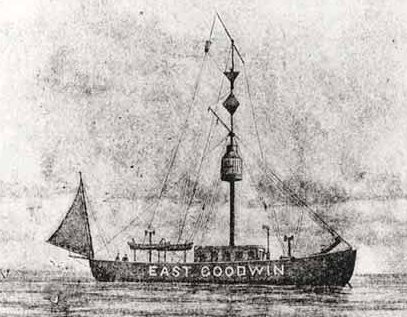First Radio Distress Signal?
 The first RADIO DISTRESS SIGNAL was transmitted from the East Goodwin Lightship on 17 March 1899 when the merchant vessel Elbe ran aground on the Goodwin Sands. The message was received by the radio operator on duty at the South Foreland Lighthouse, who was able to summon the aid of the Ramsgate lifeboat.The Goodwin Sands again featured in another ‘first’ when on 30 April 1899, the East Goodwin Sands Lightship sent a distress message on her own account when she was rammed by the SS R. F. Matthews.
The first RADIO DISTRESS SIGNAL was transmitted from the East Goodwin Lightship on 17 March 1899 when the merchant vessel Elbe ran aground on the Goodwin Sands. The message was received by the radio operator on duty at the South Foreland Lighthouse, who was able to summon the aid of the Ramsgate lifeboat.The Goodwin Sands again featured in another ‘first’ when on 30 April 1899, the East Goodwin Sands Lightship sent a distress message on her own account when she was rammed by the SS R. F. Matthews.
This was prior to the introduction of the ‘SOS’ and the recognized call sign for ships in distress then was ‘CQD’. This signal had been devised by the Marconi Company, it was intended to mean ‘All Stations – Urgent’, but was popularly misinterpreted as ‘Come Quick – Danger’ or ‘Come Quickly Down’.
 The ‘SOS’ signal was established as an International Distress Signal by an agreement made between the British Marconi Society and the German Telefunk organisation at the Berlin Radio Conference, 3 October 1906. The signal was formally introduced on 1 July 1908.
The ‘SOS’ signal was established as an International Distress Signal by an agreement made between the British Marconi Society and the German Telefunk organisation at the Berlin Radio Conference, 3 October 1906. The signal was formally introduced on 1 July 1908.
The first time the ‘SOS’ signal was used in an emergency was on 10 June 1909, when the Cunard liner SS Slavonia was wrecked off the Azores. Two steamers received her signals and went to the rescue.
Fact from: The Shell Book of Firsts. By Patrick Robertson. Elbury Press & Michael Joseph Ltd. London.

Subscribe for Daily Maritime Insights
Sign up for gCaptain’s newsletter and never miss an update
— trusted by our 109,124 members

Get The Industry’s Go-To News
Subscribe to gCaptain Daily and stay informed with the latest global maritime and offshore news

 Join The Club
Join The Club






